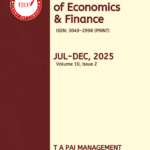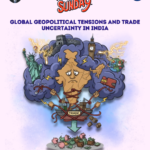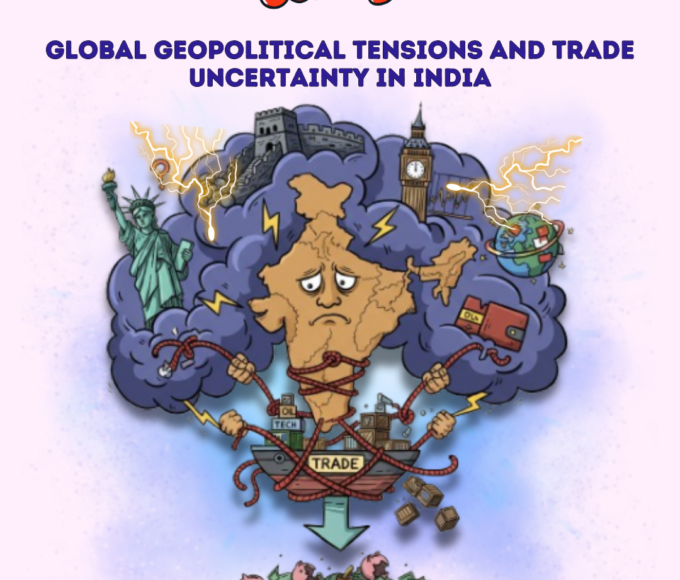
Steel is the most crucial material in industrial development and infrastructure construction, and is, therefore, of strategic importance for national transformation. Large economies around the world have achieved their economic development, prosperity, and growth strongly supported by a robust, sustainable and reliable domestic steel industry. In 2014, the Indian steel industry reeled due to scarcity of raw materials, supply-demand imbalance due to excessive capacity and moderate domestic demand, and surging imports from nations like China, South Korea, Japan, etc. in the absence of adequate tariff and non-tariff barriers against the dumping of steel and Free Trade Agreements (FTA’s) providing a very low duty protection.
The Twin balance sheet problem
In the subsequent years, the Indian economy witnessed the rise of “Twin Balance Sheet Problem” which dealt with two balance sheet problems – one with Indian companies and the other with Indian banks. Due to the oversupply of steel in the world, the prices of steel fell resulting in lower revenues. Some players had no choice but to increase their revenue by selling their products at lower prices. Further, the steel industry saw low capacity utilization leading to inadequate production and sales volume. Firms who were already exposed to excessive financial leverage struggled to make profits as lower revenues on the back of lower sales volume was insufficient to meet expenses and interest payments, thereby resulting in losses. The financial position and financial metrics are shown in Figure 1.
These highly levered firms were unable to repay their debts and their names were listed as defaulters in the Reserve Bank of India’s list of “Dirty Dozen”. Out of the 12, 5 belonged to the steel sector – Electrosteel Steels, Bhushan Steel, Bhushan Steel and Power, Monnet Ispat and Energy Ltd, and Essar Steel. These companies were dragged by lenders for Corporate Insolvency Resolution Process (CIRP) under Insolvency and Bankruptcy Code, 2016 (IBC) for amounts worth Rs.1,53,120 crores.

Introduction of IBC
The IBC proposed a paradigm shift from ‘Debtor in possession’ to a ‘Creditor in control’ regime by consolidating all existing insolvency related laws where the resolution professional of a stressed asset has to implement a resolution plan within a moratorium period of 180 days (extendable up to 270 days). If the resolution plan isn’t implemented within the stipulated time, then the company goes into liquidation.
Consolidation of existing players
IBC opened up avenues for acquisitions of stressed assets by the existing players as it was relatively cheaper to buy these companies assets rather than building a new one as investments in a similarly sized Greenfield project would have led to significant time and cost overruns. The process of consolidation began with lenders approving Tata Steel as the most eligible bidder to take over Bhushan Steel Limited (BSL) for Rs.35200 crore. Vedanta emerged as the highest bidder for the acquisition of Electrosteel Steels for Rs.5320 crores. JSW Steel emerged as the sole bidder for the acquisition of Monnet Ispat & Energy Ltd for Rs.2870 crores and was also the bid winner for Bhushan Power and Steel at Rs.19700 crores. The industry size reduced from 17 to 4 players – JSW Steel, Tata Steel, SAIL, and JSPL. SAIL and JSPL didn’t have the resources to expand themselves leaving the other two to expand their capacity base.
Strategic objectives for consolidation
The strategic objectives related to Mergers and Acquisitions (M&A’s) are to: grow at a rate faster than an organic growth rate, enter a new market or grow beyond a saturated market, capture forward and backward linkages in the value chain, attain control of key resources, market share, technology, IPR, etc. and achieve synergies of operations.
The reasons for M&A’s in the steel sector were no different with both JSW Steel and Tata Steel cementing their position as undisputed market leaders with the acquisition of Monnet Ispat and Energy Ltd (MIEL) and Bhushan Steel Ltd (BSL) respectively. Vedanta acquiring Electrosteel steels is a perfect example of forwarding integration. Bids by Arcelor Mittal and Numetal for Essar steel indicate their strong desire to enter the Indian steel industry for market penetration. It is expected that the consolidation will lead to better capacity utilization, synergy improvement, and economies of scale. This augurs well for the industry, given that these large capacities have been operating at sub-optimal utilization levels thus far. Lenders expected a recovery of a substantial portion of money previously written off as Non-Performing Assets (NPA’s) to be quickly realized which will move to a more sustainable cash flow structure.

Counter-measures
In the financial years from 2015-2018, the Indian government took a series of measures such as levy of series of anti-dumping duties and import duty on steel product imports, coal deregulation, and formulation of National Steel Policy to achieve a steel production capacity of 300 mtpa by 2030-31. With a renewed focus on infrastructure development, these measures helped Indian manufacturers to compete on par with global manufacturers in terms of pricing. There was a decline in demand for imported steel and a rise in exports of Indian steel resulting in India becoming a net exporter of steel.
The revival of domestic demand and the rise in steel prices presented the Indian steel sector as an attractive destination for global investments. The flip side is it could lead to increase in competition as Global steel giants such as Mr. Lakshmi Mittal owned Arcelor Mittal and Mr. Sanjeev Gupta owned Liberty House, who have for long tried to cement its presence in India, have evinced interest in acquiring stressed assets like Essar Steel and Bhushan Power and Steel. These players have the resources to increase capacity and to effectively meet the rising demand. If successful, there will be more established steel producers in India.
Industry players:
During 2014-15 and 2015-16, some market players tried to raise revenue by selling units at lower prices. Though it increased their market share, the costs from operations outweighed the pros of increased revenues, thereby resulting in losses. In the financial year 2015-16, every player in this industry had incurred losses from operations. In the financial year 2017, JSW Steel was the only player that earned a profit. The industry witnessed a decline in capacity utilization to 73.62% from 81% in the previous year and then rose to 76.35% on the back of improving demand conditions in the financial year 2016-17.

Pie Chart – Market share in the financial years 2014-15 and 2015-16.

Source – Refer Annexure 2 for revenue details.
Tata Steel and JSW Steel
Tata Steel and JSW Steel witnessed an improvement in revenues due to improved capacity utilization, the rise in domestic demand, and the rise in steel prices over the next three financial years. With only fewer players operating in the sector, it gave them the pricing power over their customers. The rise in steel prices resulted in higher revenues which buoyed their bottom line performance and increased their market share. Other players (including the ones under IBC) also reaped the benefits of improved business conditions, but they incurred losses from business operations. Both Tata and JSW steel earned profits from operations in the financial year 2017-18. Improvement in financial and operational performance of these companies restored the faith of the investors and lenders in the management of the firm, who wanted to finance their acquisitions using equity or debt.
Pie Chart – Market share in the financial year 2017-18.



Even though both these players were leveraged, they had the flexibility to raise funds as lenders had strong faith in the financial and operational efficiency of both these companies. Though it increased their existing financial leverage, it gave them the added advantage of improving cash flows from operating activities as a result of the revival in demand and the sharp uptick in steel prices. Tata steel raised funds in the form of rights issue for Rs.12800 crore and its subsidiary ABJA Investment Company issued a dual tranche of USD1.3 billion unsecured bonds in the international markets. They also realized approximately Rs.3,500 crores through portfolio divestment.
The acquisition of Bhushan Steel was done with the intention of capacity expansion and to enhance Tata’s product portfolio and market competitiveness in the near future. It gave them the opportunity to expand their footprints in Odisha and to strengthen their customer base across automotive, appliance, tubes, general engineering, and fabrication. Tata Steel increased its stake in Bhubaneshwar Power Private Limited (‘BPPL’) from 26% to 100% in order to increase its captive source of power to meet the growing demand. Other than Bhushan steel, Tata Steel through its subsidiary Tata Sponge Iron Limited signed definitive agreements for the acquisition of the steel business of Usha Martin Ltd for Rs 4525 crores. Usha Martin provides a rich product basket in long products segment plus operating iron ore mine, an underdevelopment thermal coal mine, and captive power plants.
Similarly, JSW steel acquired Monnet Ispat and Energy Ltd (MIEL), which is located in close proximity to the mineral-rich belts of Chattisgarh and Odisha, with the intention of production capacity expansion and to further increase their footprints in Central and Eastern markets of India. Vedanta’s acquisition of Electrosteel complements the company’s existing iron ore business as the vertical integration of steel business. Its manufacturing capabilities have the potential to generate significant efficiencies.
Tata Steel results
In the first quarter of the financial year 2018-19, they had integrated the operations of Bhushan steel and generated a revenue of Rs.37833 crores (Rs.2108 crore came from Bhushan steel) and earned a profit of Rs.1934 crores. In the second quarter, they sold 4.32 mt of steel of which 1.18 mt was sold via Bhushan steel. It generated revenue of Rs.43544 crores (Rs.5862 crore came from Bhushan steel) and reported a three-fold rise in profit from Rs.975.87 crore to Rs.3604.21 crore for the second quarter of the financial year 2018-19 in comparison to the similar period in the previous year.
Future prospects
The government’s decision to allocate Rs.5.97 lakh crore towards strengthening infrastructure is expected to boost steel demand and consumption. Demand from the housing sector, renewable energy, and the automobile sector is expected to propel the demand. Further, acquisitions of insolvent players by strong players assuage about improvement in capacity utilization of the stressed assets by transferee entities. The existing players are also planning capacity expansion by setting up manufacturing facilities in foreign countries to expand their presence and avail the benefit of rupee depreciation. Similarly, new entrants such as Arcelor Mittal entering the Indian steel market after completing the acquisition of Essar steel, Indian steel industry will witness a healthy competition as Arcelor has the technology and financial resources to scale up the capacity at Essar steel from 10 mtpa. But, these players should be cautious with their planning as an economic downturn and high leverage can weigh on their financial statements and impact their profitability.
Conclusion
A steady rise of mergers and acquisitions
activity is expected to continue in this sector as players explore inorganic
avenues to expand portfolios, optimize cost bases and strengthen balance sheets in
order to build competitive organizational structures in an otherwise cyclical
industry. The
Indian players are seeking synergy and hence they will be an active player in
the consolidation game. Lenders of stressed assets whose financial position had
been hampered by declining asset quality and profitability realized Rs.105190
crores from the sale of the 5 big insolvent steel players. Though they took a
haircut of 31.3%, they are now in a better position to make huge
investments in this sector. Stronger metals industry will emerge
post this restructuring with sustainable debt levels and with the new players entering the
industry, the whole vendor-supplier-customer relationship is going to be
reworked in the country and which is a big disruption for the front player as
well as an opportunity for many.




Note: These 6 companies aren’t the only companies in this sector. There are other players whose financials weren’t available as some were not listed. The results of those companies won’t impact much as they were quite small in scale in comparison to these 6 players. Thus, the market share calculated above gives an approximate and not accurate figure of the Indian steel industry players.
References:
- https://www.jsw.in/sites/default/files/assets/industry/steel/IR/Financial%20Performance/Annual%20Reports%20_%20STEEL/JSW_Steel_Full_AR_2014-2015.pdfEconomic survey 2017
- https://economictimes.indiatimes.com/steel-companies-bankruptcy-to-help-woo-mncs-help-consolidation/articleshow/63453011.cms
- https://timesofindia.indiatimes.com/business/india-business/ibc-process-to-push-consolidation-in-steel-industry-says-ey/articleshow/64683316.cms
- http://www.origin.tatasteel.com/media/7064/ir-fy-2017-18.pdf
- http://www.origin.tatasteel.com/media/7251/111th-agm-presentation-fy18.pdf

















Leave a comment